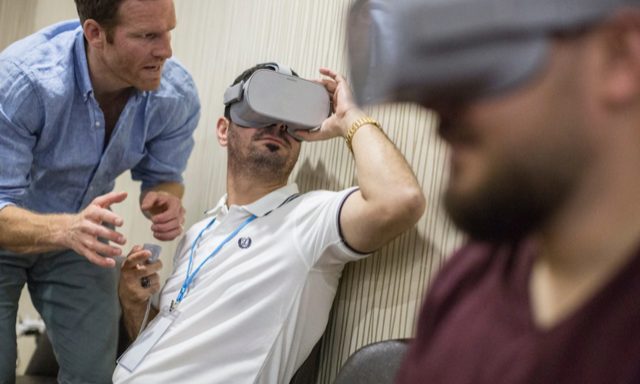Medical environments are stressful. Often, practitioners deal with life-or-death situations. From the theatre to the field in war-torn environments. Here, technology going wrong can have dramatic consequences. However, careful and correct application can make all the difference. Changes to systems, processes and interactions can be seemingly inconsequential, but in medical environments, where every second counts, they are often game changing.
Unfortunately, what needs to change is not always easy or obvious to identify, particularly from a distance. To make adaptations which matter to medical triage training in the field, or the theatre, immersion in the rich context of these environments is essential. Without it, solutions which respond to medical practitioners’ needs, cannot be accurately defined, and created.
This was the methodology deployed when working with One Shot Immersive, who provide VR training and triage applications in high threat and austere environments and Cydar Medical, the leading provider of cloud-based services that fuse images of patient data with live X-ray images to provide real-time 3D visualisations of endovascular systems.
In this article, I’ve collected learnings and considerations which can help inform the creation of more human-centred medical tools and technologies through the power of design.
Auditing the existing experience
Typically, medical technologies and experiences for clinical use are built by bigger in-house parties using pre-existing white labelled platforms. Often, they have little user-centred thinking at their core. With smaller niche players, it’s still common for systems to have been built by developers with little practitioner or patient experience as part of their product roadmap. This is despite the best intentions of founders who are often trained medical professionals.
With VR experiences for healthcare this is commonplace too. Even though experiences are inherently more visual than the things you encounter on operating theatre screens, clear navigational elements and situational queues are often overlooked. This can be because the focus is on the theatrical and immersive elements of the applications as opposed to the usability of the experience.
The engagements with both Cydar and One Shot Immersive began with auditing existing experiences, through the lens of human-centred design, before then distilling our findings into an expert review. Expert reviews typically identify fundamental usability issues from quick wins, like removing a confusing symbol or word, to more complicated design or technology challenges and changes like looking at the radius box on clicks.
Despite expert reviews being bountiful sources of best practice and insight, experience design practitioners are seldom fully trained medical professionals. That’s why contextual inquiry, to support initial assessments, is so important. Usability issues, identified as not being best practice, might obscure more fundamental issues that those who use the technology day in day out encounter.
Speak to stakeholders and understand their experiences
A good way to get started with immersion is through workshops with the health technology creators and innovators behind start-ups and scale-ups. Often, the people behind these ventures are people who have experienced the issues their technology aims to solve first-hand, as medical practitioners.
For example, the founder of One Shot Immersive, James Gough, was injured in Afghanistan. Suffering a life-threatening injury, and being the serving Doctor in his regiment, brought to life the importance of people knowing lifesaving medical triage. Moreover, it also empathised the value of rethinking how triage is taught in a way that can democratise it for people in places such as Yemen where there are only four surgeons for every 1 million people. In the UK, there is a reported 2.8 doctors per 1,000 people for example.
Contextual evaluations: the holy grail
Despite stakeholders and founders being valuable sources of information, practicing Doctors and Surgeons using the tools first-hand are the best source of insight. With Cydar interviewing people who used its EV technology regularly in endovascular surgery, helped us understand the system, the procedures and the nomenclature. This enriched our understanding of procedures and how Cydar’s tool played into them.
A step further than this, which we were fortunate enough to experience, are contextual evaluations in live operating theatres. This allowed us to see real time interactions between surgeons and the devices. This was vital because how people describe how they act can be unlike how they actually act, particularly given the situational pressures being very different from conversation to the live operating theatre.
Due to the location of the training for One Shot Immersive, we were unable to attend in person. However, associates of the business were on the ground and were able to capture in the moment responses to the VR experience. We were also able to share a survey in Arabic, which was then translated, about levels of comfort with the experience, issues such as dizziness and sickness caused by it and the ease, or absence, of learning it afforded.
Ensuring medical technology is accessible and easy to use in challenging situations
Rich experiences with both Cydar and One Shot Immersive allowed highlighted immediate issues to fix with others placed into a prioritised product roadmap to support future evolutions of the product and business model.
In all instances, the practicing healthcare professionals had a low tolerance for unnecessary ‘clutter’ and non-critical functionality within applications. Here critical functionality needed to shine through, stripping design back to more functional forms, improving both user and patient experience by allowing Doctors and Surgeons to focus on the procedure at hand.
To this end, the smallest elements of interfaces often had the biggest impact and provided the most value, this forced us to focus on micro-interactions that we may have completely overlooked. In medical technology interfaces sweating the small stuff really matters.
In surgical contexts the direct touching of interfaces can also be an issue, minimal or no touching is preferred. Where touch is required, navigation must be easy and intuitive. Where it’s limited, or supported by tools, such as handheld devices like laser pointers, affordances must be made. For example, ensuring that the systems can easily be guided by this form of interaction with elements suitably spaced and readily responsive. This ensures other elements of the interface are not unintentionally activated and that the activation of a desired element is timely.
With VR training experiences, taking graphic content into account is important because of the emotional impact it can have. Another often overlooked issue is motion sickness, this can cause discomfort and training to sometimes be cut short. Onboarding wizards supported by visual and audio cues are also important, users cannot be expected to orientate themselves in environments, even if familiar, without understanding what they’re meant to do and how they can achieve it. Forcing users to consider this can distract from the learning experience itself and limit its effectiveness if left unclear.
The devil is in the data: understanding the effectiveness of medical technology
As with any digital experience continuous improvement in the health tech space is important. Behind our work on One Shot Immersive’s VR experience was a measurement dashboard with weighted formulas powered by the survey. From this they could produce metrics around important areas of their product (immersion, motion sickness, learning, etc). This offered One Shot in the moment data from practitioners using the VR experience to train without the need of an experienced researcher. This meant they could troubleshoot in-person during the testing and then consult with us about the data later to plan changes and features into the product roadmap.
With other interface-based technology tracking is possible. With some machines now being controlled by eye, gesture or otherwise, interfaces can have underlying measurement tools, much like we see on web-based experiences, to measure the number of interactions, how many of those interactions were successful, how many interactions were performed in quick succession etc.? All of this data is valuable in composing more complete pictures of surgical usage over time when ongoing observation is not an option. Issues arising from the data can be spotted and addressed in flight, augmenting or validating the original findings from expert reviews and contextual research.
Scrubs off
Healthcare is one of most critical services a person can receive. The technology used to underpin these interactions needs to elevate the experience Surgeons and Doctors have with it. Contextual research combined with expert reviews can identify avenues for design and technology change that get to the crux of critical functionality. This means those relying on the technology have the ability to focus on offering a better patient experience without being distracted by usability issues or non-critical functionality.
Article by George Ioannou, managing partner at Foolproof, a Zensar company




